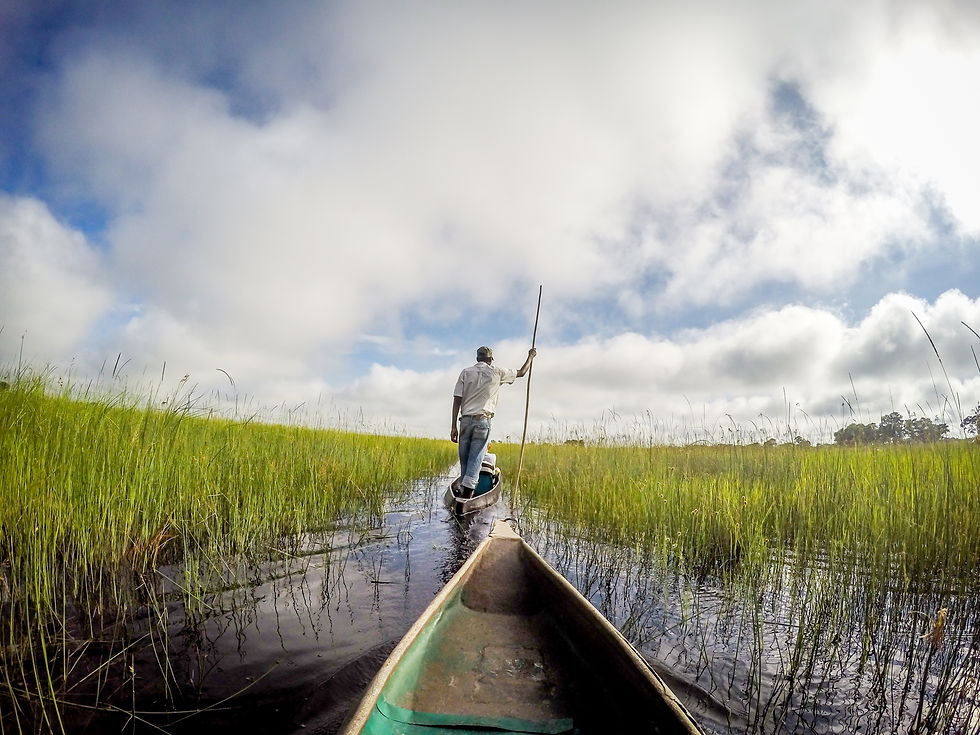ratings-display.rating-aria-label(1)
Sep 2, 2024


Updated: Feb 12
I’ll never forget the moment I watched a baby elephant learn to use its trunk in Botswana—it was adorably clumsy, splashing water everywhere and stumbling around its patient mother! That single experience sealed my love affair with Botswana’s game reserves and national parks.
Each reserve has its own unique flavor—lush wetlands, arid deserts, and everything in between—making Botswana a top contender for the ultimate African safari destination.

In this comprehensive guide, I’ll share my personal encounters, highlight lesser-known reserves, and offer practical tips to help you plan an unforgettable adventure. Whether you’re traveling on a budget or seeking high-end luxury, Botswana promises breathtaking wildlife, community-driven conservation, and a sense of wonder you won’t find anywhere else.

Unique Ecosystem: A UNESCO World Heritage Site, the Delta floods annually, attracting immense herds of wildlife seeking water and lush grazing.
Mokoro Adventures: Gliding through reed-lined channels on a traditional dugout canoe is pure magic.
Prime Predator Sightings: African Wild Dogs, Leopards, lions, cheetahs, and hyenas all call these islands home.
Travel Tip: If you love photography, plan your trip around the flood season (typically June–August) for incredible wildlife gatherings.

Private Concession: Experience exclusivity with fewer vehicles and more intimate wildlife encounters.
Luxury Meets Sustainability: Enjoy gourmet dining, spacious decks, and eco-friendly practices that support local communities.
Personal Highlight: Waking up to the sound of a rasping leopard outside my room was one of the most surreal (and thrilling) experiences of my life.
Friendly Staff: The guides and lodge staff are brimming with local knowledge—ask them about seasonal animal migrations or the history of the area.
Elephants Galore: Chobe boasts one of the largest elephant populations in Africa. You’re almost guaranteed to see these gentle giants crossing rivers or grazing by the roadside.

Safari Options: Enjoy river safaris on the Chobe River or traditional 4x4 game drives.
Diverse Wildlife: Keep an eye out for lions, buffalo, and a vibrant array of birdlife.
Insider Tip: Mornings are usually the best time for boat cruises to catch wildlife at the water’s edge—and don’t forget your camera!

Traveler Testimonial:
“I’ve been to safaris all over Africa, but nothing compares to watching a herd of elephants march through the Chobe River at sunset!” – Sarah, longtime safari enthusiast

Okavango Connection: Located in the eastern part of the Okavango Delta, Moremi is a patchwork of floodplains, forests, and lagoons.
Wild Dog Haven: This is one of the best places to spot African wild dogs; their pack hunts are a thrilling spectacle.
Birding Paradise: Kingfishers, herons, and African fish eagles thrive here, especially during flood season.
Guided Game Drives: Both day and night drives reveal the hidden secrets of Botswana’s bushveld.

Wide-Open Spaces: The second-largest game reserve in the world, defined by its arid, haunting beauty.
Desert-Adapted Wildlife: Look for oryx, springbok, and the famous Kalahari lions with their black manes.
Seasonal Wonders: After the rains, the landscape transforms into green plains teeming with grazing antelopes.
Stargazing: With virtually no light pollution, the Kalahari’s night sky is simply mesmerizing.

Wildlife viewing is at its best during the dry season from April to October, when the Okavango Delta is at its fullest, revived by the incoming flood waters. This time of year is best for mokoro excursions.


Zebra Migration: During the wet season, herds of zebras, wildebeest, and others flock to the pans.
Baines’ Baobabs: Ancient trees that appear plucked from a storybook—fantastic for photographers!
Activities: Quad biking on the salt flats is a surreal experience, and overnight camping reveals a sea of stars overhead.
Atmospheric Silence: The emptiness has an almost spiritual quality, perfect for those seeking quiet introspection.

Botswana isn’t just about national parks; private game reserves and concessions often provide a more exclusive safari. These areas usually limit the number of visitors, allowing for quieter wildlife encounters and a chance to support local conservation work.
Riverside Paradise: The Selinda Spillway connects the Okavango Delta to the Linyanti wetlands.
High Predator Density: Known for incredible leopard and lion sightings.
Land of Giants: Named for its numerous Mashatu trees, also home to large elephant herds.
Adventure Activities: Horseback safaris and mountain biking safaris are possible here.
Untamed Wilderness: Adjacent to Moremi Game Reserve, known for big cat sightings and diverse water channels.
Small, Intimate Camps: Enjoy a personal touch from highly skilled guides.
“At Mashatu, we cycled alongside giraffes at a respectful distance—an insane, once-in-a-lifetime experience!” – John, adventure cyclist

Visas & Regulations: Check the latest visa rules for your nationality. Regulations can change, so stay updated.
Park Fees: Entry fees vary between parks and private concessions. Some offer multi-day passes, which can be cost-effective.
Health Precautions: Consult a travel clinic about malaria prophylactics and other vaccinations.
Packing Essentials: Binoculars, neutral-colored clothing, insect repellent, and a wide-brimmed hat are your best friends.
Best Time to Visit:
Dry Season (May–October): Peak wildlife visibility, but nights can be chilly.
Wet Season (November–April): Vibrant landscapes, fewer tourists, and excellent birdwatching.

Best Time to Visit Botswana – Find out when to see peak wildlife activity and enjoy comfortable weather.
Safari Packing Guide – Don’t leave home without these essentials!
Luxury Lodges in the Okavango Delta – Explore top-notch accommodations for a dream safari.
Botswana’s tapestry of game reserves and national parks weaves together unrivaled wildlife encounters, breathtaking scenery, and a deep-rooted respect for conservation. From the moment you spot a herd of elephants trekking through Chobe to your first mokoro ride in the Okavango Delta, you’ll realize that this journey is about more than ticking off a travel bucket list—it’s a profound connection to the heart of Africa.
For me, every return to Botswana feels like coming home. If you’re ready to experience the thunder of hooves across the savannah or the silent grace of a leopard at dusk, plan your Botswana game reserve adventure now. With the right preparation and a spirit of wonder, you’ll walk away with stories (and photos!) that you’ll be sharing for years to come.